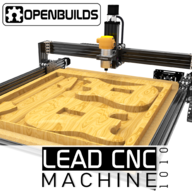OpenBuilds LEAD CNC
Discussion in 'CNC Mills/Routers' started by MaryD, Nov 20, 2018.
LEAD CNC 1010 (40" x 40")
Discussion in 'CNC Mills/Routers' started by MaryD, Nov 20, 2018.
The OpenBuilds Lead Machine takes us back to the roots of the OpenBuilds modular building system, and has proven itself as an adaptable design that can compete with any machine in its class!
Page 7 of 34
Page 7 of 34
